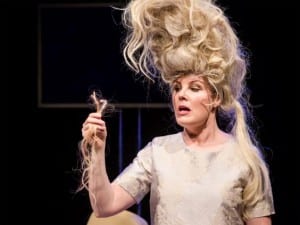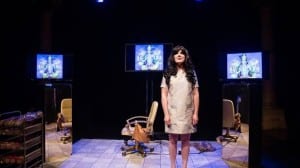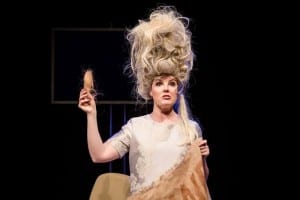Victoria Melody’s Hair Peace was a creative masterpiece exploring the roots of human hair (pardon the pun). Melody takes the audience on an entertaining journey into the world of beauty and to the extent people will go in order to feel and look ‘good’. Melody journey’s to India in an attempt to find out where many of the “real human hair” (Melody, 2016) extensions actually come from.

Her journey began from the end of her last show Major Tom, where she entered her dog in to Crufts style competitions. This prompted her in to an exploration of beauty pageants. Melody entered herself in to these pageants in an attempt to uncover what it is to be attractive and how ‘natural’ beauty holds up to a lesser more artificial one. Her time in beauty pageants led her to the realisation that hair extensions, a common tool used by aspiring queens, were acquired from real people in eastern countries.
Hair Peace took us on a journey from England to India documenting the miles a single strand of hair will rack up on it’s way to another person’s head. Whether it came from an street market vendor who bought hair from the deceased or whether it was salvaged from an ancient ritual in relationship to God:
“There is a saviour in the shape of a Bollywood financier, the most expensive wedding to have ever taken place, a Celebrity Big Brother contestant, and hair.Lots of hair. Sacks of it” (Melody, 2010)

What I learned from Hair Peace
Victoria Melody’s semi-autobiographical venture allowed me to see the benefits of using autobiographical elements in a performance in order to further contextualise the topic that is brought to the table. The show’s concept is brought into the realm of human feeling by the autobiographical and biographical element that Melody includes; using the stories of Melody and her friends and family allows the topic at hand to be brought right in to the forefront of the audience’s mind – rather than keeping the topic of hair and the emotional journeys the religious pilgrims go through in order to have their hair removed for purposes of worship.
Melody makes no attempt to persuade the audience that she is anyone else, her performance contains no character work and it allows the audience to see a personal viewpoint on the subject at hand: “She is totally herself on stage, finding out about the world and discovering herself in the very act of performance. Her openness and disarming directness make us warm to her” (The Guardian, 2015).

Works Cited.
Melody, V. (2016) Hair Peace. [performance] Paul Hodson (dir.) Lincoln: LPAC, 2 March.
Melody, V. (2010) Hair Peace. [online] Warwick: Parachutes and Puzzles. [Accessed 8 march 2016]
The Guardian. (2015) Hair Peace at Edinburgh Festival review – the secret life of locks. The Guardian, 24 August.
